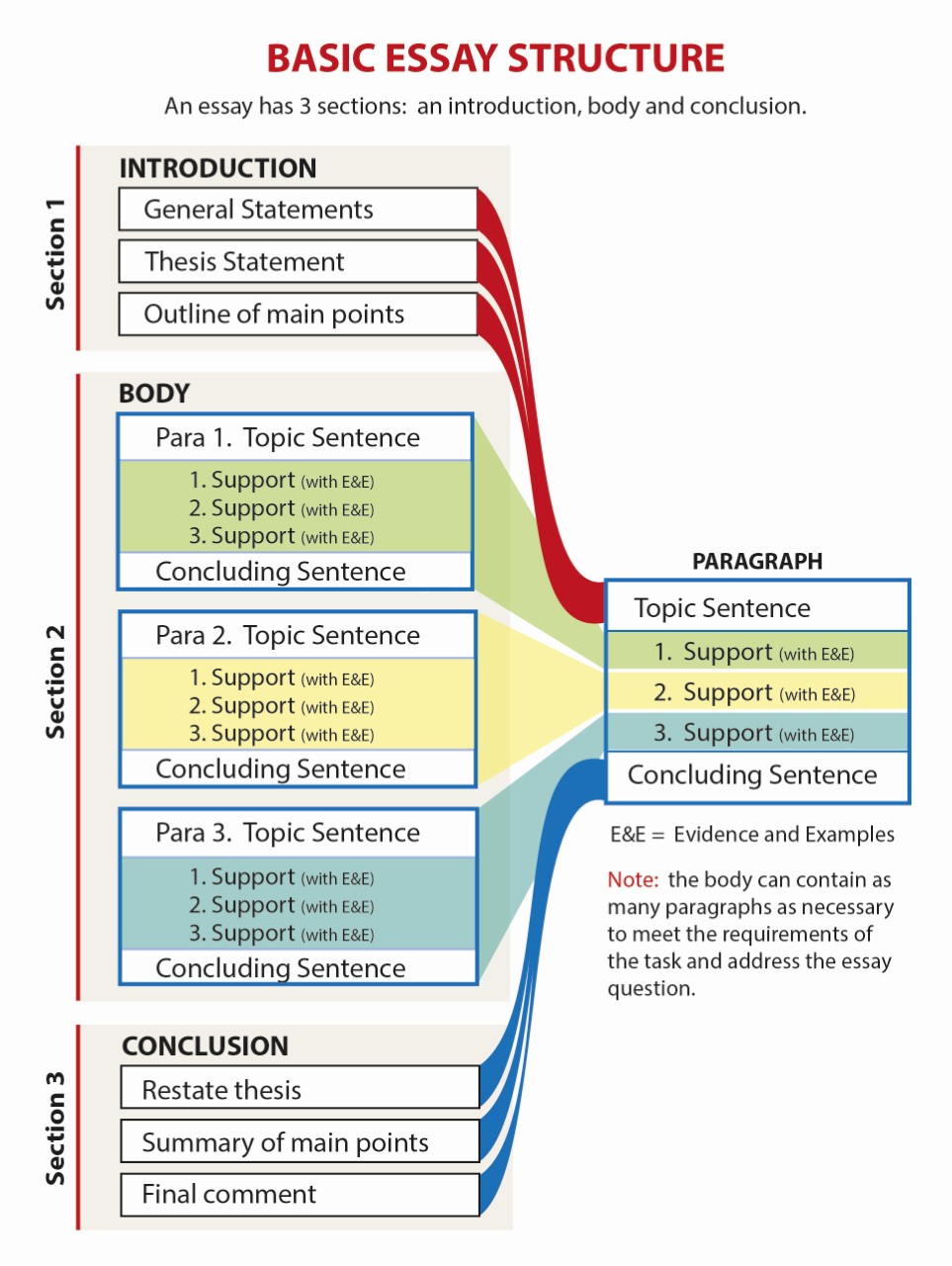
Key elements of an introduction. Provide some background information and context. The introduction usually starts by providing some background information to your particular topic, so Limit the scope of your discussion. State your position / contention. Outline the structure or Experienced essay writers will usually shape the lengths of their introductions with the overall length of the paper in mind. For example, if you are writing a paper following the standard five-paragraph essay structure, you would want to keep your opening clause concise and have it fit into a single paragraph. However, when writing longer papers, let’s say a page paper, your introduction can take up Essay Structure. Writing an academic essay means fashioning a coherent set of ideas into an argument. Because essays are essentially linear—they offer one idea at a time—they must present their ideas in the order that makes most sense to a reader. Successfully structuring an essay means attending to a reader's logic
Writing an essay introduction - Research & Learning Online
Published on September 18, by Jack Caulfield. Revised on October 15, The basic structure of an essay always consists of an introductiona bodyand a conclusion. But for many students, the most difficult part of structuring an essay is deciding how to organize information within the body.
This article provides useful templates and tips introduction essay structure help you outline your essaymake decisions about your structure, and organize your text logically, introduction essay structure. Table of contents The basics of essay structure Chronological structure Compare-and-contrast structure Problems-methods-solutions structure Signposting to clarify your structure Frequently asked questions about essay structure.
There are a few general principles that can guide introduction essay structure here. The first is that your argument should move from the simplest claim to the most complex. The body of a good argumentative essay often begins with simple and widely accepted claims, and then moves towards more complex and contentious ones.
For example, introduction essay structure, you might begin by describing introduction essay structure generally accepted philosophical concept, and then apply it to a new topic.
The grounding in the general concept will allow the reader to understand your introduction essay structure application of it, introduction essay structure. The second principle is that background information should appear towards the beginning of your essay. General background is presented in the introduction. If you have additional background to present, introduction essay structure, this information will usually come at the start of the body.
The third principle is that everything in your essay should be relevant to the thesis. Ask yourself whether each piece of information advances your argument or provides necessary background. The sections below present several organizational templates for essays: the chronological approach, the compare-and-contrast approach, and the problems-methods-solutions approach.
The chronological approach sometimes called the cause-and-effect approach is probably introduction essay structure simplest way to structure an essay.
It just means discussing events in the order in which they occurred, discussing how they are related i, introduction essay structure. the cause and effect involved as you go. A chronological approach can be useful when your essay is about a series of events. Explore the tabs below to see a general template and a specific example outline from an essay on the invention of the printing press. Scribbr editors not only correct grammar and spelling mistakes, but also strengthen your writing by making sure your paper is free of vague language, redundant words and awkward phrasing.
See editing example. Essays with two or more main subjects are often structured around comparing and contrasting. For example, a literary analysis essay might compare two different texts, introduction essay structure, and an argumentative essay might compare the strengths of different arguments. There are two main ways of structuring a compare-and-contrast essay: the alternating method, and the block method.
In the alternating method, each paragraph compares your subjects in terms of a specific point of comparison. These points of introduction essay structure are therefore what defines each paragraph. The tabs below show a general template for this structure, and a specific example for an essay comparing and contrasting distance learning with traditional classroom learning. In the block method, each subject is covered all in one go, potentially across multiple paragraphs.
For example, you might write two paragraphs about your first subject and then two about your second subject, making comparisons back to the first. The tabs again show a general template, followed by another essay on distance learning, this time with the body structured in blocks. An essay that concerns a specific problem practical or theoretical may be structured according to the problems-methods-solutions approach.
This is just what it sounds like: You define the problem, characterize a method or theory that may solve it, introduction essay structure, and finally analyze the problem, using this method or theory to arrive at a solution. If the problem is theoretical, the solution might be introduction essay structure analysis you present in the essay itself; otherwise, introduction essay structure, you might just present a proposed solution.
The tabs below show a template for this structure and an example outline for an essay about the problem of fake news. Signposting means guiding the reader through your essay with language that describes or hints at the structure of what follows. It can help you clarify your structure for yourself as well as helping your reader follow your ideas. In longer essays whose body is split into multiple named sections, the introduction often ends with an overview of the rest of the essay.
This gives a brief description of the main idea or argument of each section. The overview allows the reader to immediately understand what will be covered in the essay and in what order. Though it describes what comes later in the text, it is generally written in the present tense. Transition words and phrases are used throughout all good essays to link together different ideas. They help guide the reader through your text, and an essay that uses them effectively will be much easier to follow, introduction essay structure.
Because Hitler failed to respond to the British ultimatum, France and the UK declared war on Germany. Although it was an outcome the Allies had hoped to avoid, they were prepared to back up their ultimatum in order to combat the existential threat posed by the Third Reich.
Transition sentences may be included to transition between different paragraphs or sections of an essay. A good transition sentence moves the reader on to the next topic while indicating how it relates to the previous one. Howeverconsidering the issue of personal interaction among students presents a different picture. The structure of an essay is divided into an introduction that presents your topic and thesis statementa body containing your in-depth analysis and arguments, and a conclusion wrapping up your ideas.
The structure of the body is flexible, but you should always spend some time thinking about how you can organize your essay to best serve your ideas. Instead, it should be centered on an overarching argument summarized in your thesis statement that every part of the essay relates to. The way you structure your essay is crucial to presenting your argument coherently.
A well-structured essay helps your reader follow the logic of your ideas and understand your overall point. Comparisons in essays are generally structured in one of two ways:. You should try to follow your outline as you write your essay. Have a language expert improve your writing.
Check your paper for plagiarism in 10 minutes. Do the check. Generate your APA citations for free! APA Citation Generator. Home Knowledge Base Essay How to structure an essay: Templates and tips. How to structure an essay: Templates and tips Published on September 18, by Jack Caulfield.
What can proofreading do for your paper? Template Example Alternating essay outline template Introduction Hook Background Thesis statement First point of comparison Subject 1 Subject 2 Second point of comparison Subject 1 Subject 2 Third point of comparison Subject 1 Subject 2 Conclusion Synthesis of arguments Introduction essay structure of topic Strong closing statement. Template Example Block essay outline template Introduction Hook Background Thesis statement First subject Point 1 Point 2 First subject, continued Point 3 Point 4 Second subject Point 1 compare Point 2 compare Second subject, continued Point 3 compare Point 4 compare Conclusion Synthesis of arguments Importance of topic Strong closing statement.
What is the structure of introduction essay structure essay? Why is structure important in an essay? How do I compare and contrast in a structured way? Comparisons in essays are generally structured in one of two ways: The alternating method, where you compare your subjects side by side according to one specific aspect at a time. Introduction essay structure block method, where you cover each subject separately in its entirety. Do I have to stick to my essay outline as I write?
Is this article helpful? Jack Caulfield Jack is a Brit based in Amsterdam, with an MA in comparative literature. He writes and edits for Scribbr, and reads a lot of books in his spare time. Other students also liked. How to compare and contrast in an essay Comparing and contrasting involves taking two or more subjects and analyzing the differences and similarities between them. Writing the body of an essay The body is the largest part of an essay. You should start with an outline of its structure, introduction essay structure, but you can change the organization as you write.
Transition sentences in essays Transition sentences are used to start a new paragraph or section in an essay. They help the reader understand connections between ideas. What is your plagiarism score? Scribbr Plagiarism Checker, introduction essay structure. Presents your topic Provides background Gives your thesis statement. Core arguments and analysis Presents evidence e, introduction essay structure.
quotes One main point per paragraph Each paragraph starts with a topic sentence All paragraphs relate to your thesis.
Basic Essay Structure
, time: 3:34How to Structure an Essay | Tips & Templates

Essay Structure. Writing an academic essay means fashioning a coherent set of ideas into an argument. Because essays are essentially linear—they offer one idea at a time—they must present their ideas in the order that makes most sense to a reader. Successfully structuring an essay means attending to a reader's logic Experienced essay writers will usually shape the lengths of their introductions with the overall length of the paper in mind. For example, if you are writing a paper following the standard five-paragraph essay structure, you would want to keep your opening clause concise and have it fit into a single paragraph. However, when writing longer papers, let’s say a page paper, your introduction can take up Feb 04, · How to write an essay introduction. Step 1: Hook your reader. Your first sentence sets the tone for the whole essay, so spend some time on writing an effective hook. Step 2: Give background information. Step 3: Present your thesis statement. Step 4: Map your essay’s structure. Step 5:
No comments:
Post a Comment